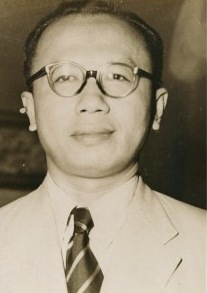Djuanda Kartawidjaja
Djuanda Kartawidjaja | |||||||||||||
|---|---|---|---|---|---|---|---|---|---|---|---|---|---|
 Official portrait, 1959 | |||||||||||||
| 11th Prime Minister of Indonesia | |||||||||||||
| In office 9 April 1957 – 9 July 1959 | |||||||||||||
| President | Sukarno | ||||||||||||
| Deputy | |||||||||||||
| Preceded by | Ali Sastroamidjojo | ||||||||||||
| Succeeded by | |||||||||||||
| |||||||||||||
| Personal details | |||||||||||||
| Born | 14 January 1911 Tasikmalaya, Preanger Residency, Dutch East Indies | ||||||||||||
| Died | 7 November 1963 (aged 52) Jakarta, Indonesia | ||||||||||||
| Alma mater | Technische Hoogeschool te Bandoeng | ||||||||||||
Djuanda Kartawidjaja (
Born into a
Djuanda's death and the abolition of the post of Prime Minister in the Indonesian Republican system allowed far greater power to be exercised by the President, now being given full ruling power with minimal oversight, as both Head of State and Head of Government. This had an enormous impact on Indonesian politics, allowing the constitutional legality of the autocracy of Sukarno and Suharto, also contributing to the absence of an economic policy in the later years of Sukarno's Guided Democracy.
Since his death, various landmarks have been named in his honor, including
Early life
Djuanda Kartawidjaja was born on 14 January 1911, in
Early career
He became a teacher at a Muhammadiyah Islamic School in Batavia (now Jakarta), eventually becoming the principal of the school. In 1937, he became an engineer in the West Java Water Conservancy Bureau. In 1939, he became a senior advisor to the bureau. In addition, he also actively participated in the work of the Batavia Municipal Council.[1] In 1942, the Japanese Empire invaded and occupied the Dutch East Indies. The Japanese changed Batavia to its current name Jakarta. In the same year, Juanda participated in the Jakarta City Council election but was not elected.[4][5]
National revolution
In 1943, the Japanese appointed Indonesian advisors (sanyo) to the administration and appointed nationalist leader Sukarno leader of a new Central Advisory Board (Chuo Sani-kai) in Jakarta. On 7 August, the day after the atomic bombing of Hiroshima, the Preparatory Committee for Indonesian Independence (Indonesian: Panitia Persiapan Kemerdekaan Indonesia) or PPKI was established. Sukarno was chairman, and Mohammad Hatta as vice chairman. On 19 August 1945, this body created 12 ministries for Indonesia's first cabinet, the Presidential cabinet.
Juanda was known as the "marathon minister." In the
He was also trusted to lead Dutch negotiations, one of which was negotiations at the Round Table Conference. During the conference, Djuanda was sent to be the Chair of the Economic and Finance Committee for the Indonesian Delegation. In the negotiations, the Netherlands officially recognized the independence of the Indonesian government.
Djuanda was also entrusted to lead the Japanese Railways Bureau. This was followed by the takeover of the Mining Bureau, Municipality, Residency and military objects in North Bandung Warehouse. After carrying out this task, he was appointed Head of the Railway Bureau for the
Political career (1950–1963)
Prime Minister of Indonesia
Djuanda declaration

The Djuanda Declaration which was initiated on 13 December 1957 by Djuanda. This declaration stated to the world that the Indonesian seas included the seas around, between and within the Indonesian archipelago into one unitary territory of the Republic of Indonesia or in the convention on the law of the sea. United Nations Convention on the Law of the Sea (UNCLOS), is known as an archipelagic state.
The content of this Juanda Declaration states:
- That Indonesia declares as an archipelagic country that has its own style
- That since time immemorial, the archipelago has been a single entity
- The provisions of the 1939 Ordinance concerning the Ordinance, can divide the territorial integrity of Indonesia. The declaration contains a purpose:
- To realize the form of the territory of the Unitary Republic of Indonesia which is complete and round
- To determine the boundaries of the territory of the Republic of Indonesia, in accordance with the principles of the Archipelago State
- To regulate peaceful shipping traffic that further ensures the security and safety of the Unitary State of the Republic of Indonesia
The statement read by Djuanda became the legal basis for the drafting of the law used to replace the Territoriale Zee en Maritime Kringen Ordonantie in 1939.
Death (1963)
On the afternoon of 6 November 1963, Djuanda, accompanied by his wife and daughter, went to a hotel in Jakarta to participate in the opening ceremony. He fell suddenly at 11:25 p.m., and his pulse stopped 20 minutes later. His personal doctor rushed to the scene and gave him artificial respiration, but it was unsuccessful. On 7 November, the Indonesian government announced that Djuanda died of a heart attack.
Legacy
After his death, Djuanda was appointed a national figure, based on the Decree of the President of the Republic of Indonesia No. 224/1963.
Honours
 Malaya: Honorary Grand Commander of the Order of the Defender of the Realm (SMN) (K) – Tun (1959)[8]
Malaya: Honorary Grand Commander of the Order of the Defender of the Realm (SMN) (K) – Tun (1959)[8]
References
- ^ a b "Dinas Kehutanan Provinsi Jawa Barat". dishut.jabarprov.go.id. Archived from the original on 26 September 2021. Retrieved 26 September 2021.
- ^ a b "Profil - Djuanda Kartawidjaja". merdeka.com. Retrieved 26 September 2021.
- ^ "Djuanda Kartawidjaja". tirto.id (in Indonesian). Retrieved 26 September 2021.
- OCLC 643403609.
- )
- ISBN 979-428-499-8(Indonesian).
- ^ Angga Aliya ZRF (19 December 2016). "Rupiah Desain Baru Terbit Hari Ini". detikfinance. Retrieved 26 January 2017.[permanent dead link]
- ^ "Senarai Penuh Penerima Darjah Kebesaran, Bintang dan Pingat Persekutuan Tahun 1959" (PDF).
Bibliography
- Ricklefs (1982), A History of Modern Indonesia, Macmillan Southeast Asian reprint, ISBN 0-333-24380-3
- Simanjuntak, P.H.H (2003) Kabinet-Kabinet Republik Indonesia: Dari Awal Kemerdekaan Sampai Reformasi (Cabinets of the Republic of Indonesia: From the Start of Independence to the Reform Era), Penerbit Djambatan, Jakarta, ISBN 979-428-499-8

